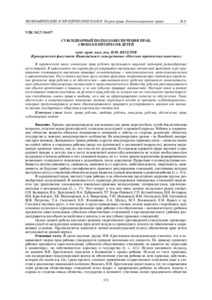Please use this identifier to cite or link to this item:
https://elib.psu.by/handle/123456789/24359Full metadata record
| DC Field | Value | Language |
|---|---|---|
| dc.contributor.author | Веселов, Н. Ю. | - |
| dc.date.accessioned | 2020-02-06T11:27:37Z | - |
| dc.date.available | 2020-02-06T11:27:37Z | - |
| dc.date.issued | 2019 | - |
| dc.identifier.citation | Вестник Полоцкого государственного университета. Серия D, Экономические и юридические науки. - 2019. - № 6. – С. 131-138. | ru_RU |
| dc.identifier.issn | 2070-1632 | - |
| dc.identifier.uri | https://elib.psu.by/handle/123456789/24359 | - |
| dc.description | Subsidiary Approach to Ensuring the Rights, Freedoms and Interests of Children N. Veselov | ru_RU |
| dc.description.abstract | В юридической науке институт прав ребенка представлен широкой палитрой разнообразных исследований. В зависимости от характера регулирования ювенальных отношений выделяют три традиционно сложившиеся ювенально-правовые метадоктрины – патерналистская, протекционистская и автономистская. На сегодня в научном кругу можно выделить сторонников двух подходов в определении феномена прав ребенка и их обеспечения – автономистского (ребенок признается самостоятельным субъектом общественных отношений) и протекционистского (будто бы ребенок рассматривается как объект воздействия и защиты, а не как субъект правовых отношений). Научный поиск в рамках исследования позволил взглянуть на феномен прав ребенка не только как на естественно предоставленную способность иметь права и свободы, но и как на сформированную систему их обеспечения. Такое обеспечение в концептуальном понимании должно строиться исходя из принципа «субсидиарности», который предусматривает режим сбалансированного правового регулирования и влияния или вмешательства государства и общества в ювенальные отношения.= In legal science, the Institute for the Rights of the Child is represented by a wide palette of diverse studies. Depending on the nature of the regulation of juvenile relations, three traditionally established juvenile-legal metadoctrines are distinguished – paternalistic, protectionist, and autonomist. Today, the scientific community can be divided into two main camps of supporters – the autonomist (the child is recognized as an independent subject of social relations) and protectionist (if the child is considered as an object of influence and protection, and not as a subject of legal relations) approaches in determining the phenomenon of the rights of the child and their provision. The scientific search within the framework of the research allowed to look at the phenomenon of the rights of the child, not only as the naturally granted ability to have rights and freedoms, but also as a formed system of their provision. Such a provision, in conceptual understanding, should be based on the principle of “subsidiarity”, which provides for a regime of balanced legal regulation and the influence or interference of the state and society in juvenile relations. | ru_RU |
| dc.language.iso | ru | ru_RU |
| dc.publisher | Полоцкий государственный университет | ru_RU |
| dc.relation.ispartof | Веснік Полацкага дзяржаўнага ўніверсітэта. Серыя D, Эканамічныя і юрыдычныя навукі | be_BE |
| dc.relation.ispartof | Herald of Polotsk State University. Series D, Economics and law sciences | en_EN |
| dc.relation.ispartof | Вестник Полоцкого государственного университета. Серия D, Экономические и юридические науки | ru_RU |
| dc.relation.ispartofseries | Серия D, Экономические и юридические науки;2019. - № 6 | - |
| dc.rights | open access | ru_RU |
| dc.subject | Государственный рубрикатор НТИ - ВИНИТИ::ОБЩЕСТВЕННЫЕ НАУКИ::Государство и право. Юридические науки | ru_RU |
| dc.subject | Дети | ru_RU |
| dc.subject | Права ребенка | ru_RU |
| dc.subject | Свободы ребенка | ru_RU |
| dc.subject | Интересы ребенка | ru_RU |
| dc.subject | Обеспечение прав | ru_RU |
| dc.subject | Субсидиарный подход | ru_RU |
| dc.subject | Сhildren | ru_RU |
| dc.subject | Сhild rights | ru_RU |
| dc.subject | Сhild freedoms | ru_RU |
| dc.subject | Сhild interests | ru_RU |
| dc.subject | Ensuring rights | ru_RU |
| dc.subject | Subsidiary approach | ru_RU |
| dc.title | Субсидиарный подход обеспечения прав, свобод и интересов детей | ru_RU |
| dc.type | Article | ru_RU |
| dc.identifier.udc | 342.7:34.037 | - |
| Appears in Collections: | 2019, № 6 | |
Files in This Item:
| File | Description | Size | Format | |
|---|---|---|---|---|
| 131-138.pdf | 654.55 kB | Adobe PDF |  View/Open |
Items in DSpace are protected by copyright, with all rights reserved, unless otherwise indicated.